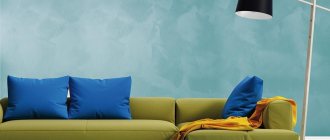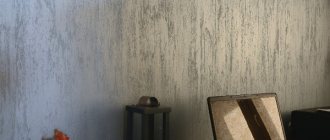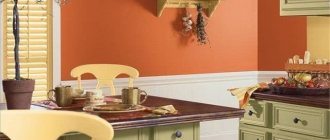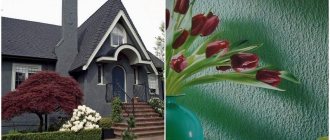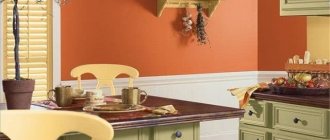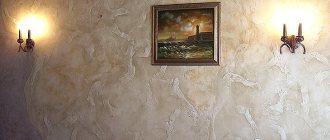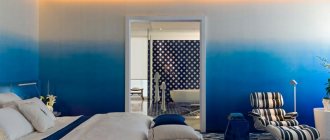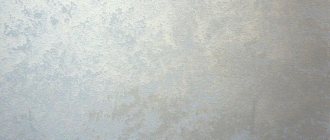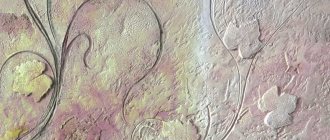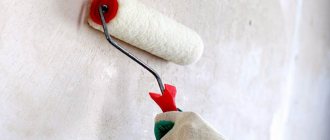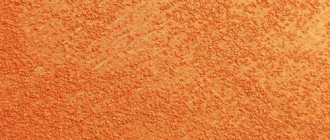Advantages of decorative paints
Dyes for wall decoration, as a type of finishing material, are characterized by many advantages:
- The service life of painted coatings is several times higher than that of wallpaper or plaster.
- There are no joints on the painted surface, resulting in a perfect continuous picture.
- A huge range of different colors and effects.
- Moisture-resistant properties help make walls unique even in the kitchen and bathroom.
- In case of repainting, there is no need to clean the existing paint layer.
- The use of water-based paint when decorating guarantees an environmentally friendly surface that does not emit toxic substances and does not cause allergies, and is an ideal solution for decorating a child’s bedroom.
- Regardless of the base surface (be it concrete, drywall, plaster), it fits equally well on the wall.
Decorative painting of walls has only one requirement for the coating - it must be even.
What effects can be created on the wall using ready-made decorative paint?
There are a variety of coloring agents that impart different types of texture to the base. You can highlight the following options for applying paint to walls instead of wallpaper:
- Imitation velor;
- Mother-of-pearl walls will glow differently from different points;
- Imitating granite;
- Sea resources can be added to the components to create an original texture.
There are a variety of coloring agents that impart different types of texture to the base.
Painting tools
Apart from the paint itself, painting walls in an apartment is done using the following tools:
- roller;
- spatulas (metal, plastic, toothed, rubber);
- sponges;
- hard brush;
- sandpaper;
- stencil (for the effect of a pattern on a painted wall).
Before you start decorating the walls, you need to decide what decorative effect you want to achieve, so as not to buy extra tools. Although the price of rollers and brushes is low, you can use them more than once.
Mistakes when painting house walls
When decorating walls in the interior, many beginners make commonplace mistakes that can be avoided if you know the technology:
- Always prime the wall! Some people skip this point out of ignorance or a desire to save money. Remember, paint cannot adhere to bare putty or plaster. This is a dusty surface, due to which the decorative layer may crumble. Often painted walls simply “peel off” in large flakes. It’s better to spend 300 rubles on 5 liters of the cheapest acrylic primer than to redo the repair.
- Unprepared walls. Unlike wallpaper, the paint layer is flat and any unevenness in the walls is clearly visible on it. Even the smallest bumps will immediately catch your eye. The paint requires alignment using beacons and checking at a laser level.
- Tinting. It is better to have tinting done in a suitable salon. If this is not possible, at least use a kitchen scale to mix the base and color in the same proportions. Only then will the color of the wall paint remain uniform.
Preparing the walls
If decorating a wall with paint is being done for the first time, you need to prepare the surface for such a design solution. Preparing walls for primary painting is carried out in stages:
- Cleaning the coating from old finishes.
- Surface priming.
- Inspection for flaws, which are repaired if necessary.
- Uneven surfaces are puttied and sanded.
- Re-priming.
After all the work done, the wall is ready for decorative painting.
In order for the paint to lay evenly on the walls and to avoid any defects on the coating, you must wait until the putty mixture and primer on the wall have completely dried.
Wallpaper or painting walls: all the pros and cons
Whether to choose paint instead of wallpaper is decided by taking into account the operating conditions. Speaking about the cost, it is noted that it is impossible to answer with certainty. A large area and the use of special products for decoration lead to the same cost as when using wallpaper.
Design solutions involve gluing wallpaper and painting in one room, creating a stylish combination of materials.
Design solutions involve gluing wallpaper and painting work in one room.
Types of wall decoration with paint
Due to the fact that decorative paint is too expensive, an alternative is in demand among construction professionals - artistic painting of walls with ordinary cheap paint. There are several varieties to create a unique room using ordinary paints. Let's take a closer look at them.
Stippling
This is the name for painting walls with decorative paint, which creates the effect of an old, shabby surface. To create such a masterpiece you need:
- Cover the surface with the chosen color.
- Apply acrylic paint to create a contrasting shade.
- Apply colored glaze to the surface in combination with the shade of the painted wall, smooth it evenly over the surface with a wide brush, and when all surfaces are covered with glaze, touch the uncured paint with the same brush.
- A round paint brush should be poked in a chaotic manner over the surface, thus making the walls look antique.
There is only one drawback to this method of application: all irregularities and bulges become more noticeable.
Skin effect
This decorative coloring is a great idea for decorating an office; it gives the impression that the walls are covered in leather. After preparing the surface, you need to start finishing:
- We cover the walls with latex paint of our favorite color.
- Making a suede tassel.
- Mix the glaze with latex paint, slightly darker than the tone of the surface.
- We cover a piece of the surface with the mixture, moisten a suede brush in water and squeeze it out, lightly touch it over the not-dried coating, making streaks and partially removing it.
- We blot the existing noticeable lines with a piece of wet suede to give a natural leather finish.
Venetian plaster effect
One of the most beautiful and decorative ways to paint walls. To recreate the Venetian effect, you must complete the following steps:
- Place latex paint in a wide container. Sprinkle a little pigment for paint on one side, carefully stir half with a stick so that the dark and light sides come out in the container.
- We take a lighter paint on a spatula and apply it to the coating like regular plaster.
- Dip a spatula in a dark color and cover a piece of the wall.
- When light and dark spots appear on the wall, we begin to move the spatula along the wall in different directions to evenly smear the colors for a harmonious look.
At the finishing stage, Venetian plaster is sanded with fine sandpaper and rubbed with a special wax composition.
To create the “Venetian plaster” effect, you must use only a plastic spatula during the work process.
Wrinkled skin effect
This effect is easy to create, but requires patience, because everything is done slowly, gradually.
- Take a piece of paper and paint a piece of the wall according to its size.
- We crumple the sheet, apply it to the surface, begin to smooth it, while creating the outline of a crumpled coating.
The entire wall is gradually processed in small pieces.
In the video: the effect of wrinkled (worn) leather on the wall.
Painting with a rag roller
For decorative painting of walls, you can use not only purchased tools, but also improvised means. A simple rag roller creates an interesting indoor effect that is suitable for children's rooms. If this method is used, the surface preparation may not be ideal, because this type of finish hides all imperfections on the wall.
Roller painting steps:
- Apply the first layer of paint and wait for it to dry.
- Dilute another shade of the base color (slightly darker than the previous one).
- We soak a rag in paint, twist it to make a tourniquet, and wrap it around the roller.
- We paint from the very top of the wall to the bottom in different directions to obtain a textured pattern.
How to paint the walls yourself
To create an interesting-looking and original structure, you don’t need any special equipment. Everything can be easily found in the apartment. These are unusual budget options for tools that will definitely arouse interest.
Broom
One of the main unusual ways. Using an ordinary straw broom, you can decorate the walls with noticeable stripes. The paint can be one color, or you can combine dark and light colors. It will be convenient to use this option if the paint is textured. On it the drawing is expressed more clearly. This option is convenient to use instead of wallpaper.
The only point is that it is advisable to apply a new layer after about 40 minutes so as not to smear the first one. You can start texturing immediately after applying the contrasting tone. To do this, you need to walk with a broom along the entire wall from top to bottom.
Shoe brush
If you want to get a decor that looks like silk, you can use a brush with stiff bristles. It’s easier to work with than a broom, but the principle is the same. You can make vertical or horizontal stripes. The main thing is to move in one direction. Timely cleaning of the bristles from excess paint will help maintain the clarity of the stripes. The result can compete with decorative plaster.
Foam sponge
A regular dish sponge will help give the walls a grainy texture. The main secret of this method is that before starting you need to dip the sponge in the paint and then remove the excess. Only then can you apply prints to the newly painted surface. The movements should be blotting. If you change the position of your hand, you can diversify the pattern.
Cloth rag
When trying to create a textured surface, a simple rag will be as helpful as any other. Having painted the wall in the desired color, the fabric must be soaked in paint of a different color, then crumpled well and walked over the entire surface, leaving prints as close to each other as possible. Only then will the pattern be uniform.
If you take a rag and do not dip it into paint of the same or a different color, the effect will not be so rich and visible.
To speed up and make work easier, a rag can be wrapped around the roller drum.
Plastic bag
It will create the effect of crumpled paper on the paint. To do this, you need to take a larger bag and cut off one side. Then apply it to the newly painted wall without smoothing out the wrinkles. And finally, go over it with a roller to leave impressions. All that remains is to carefully remove the bag by pulling the corner of the layer. The effect is impressive.
These interesting techniques will help give your room a whole new look.
Types of paints
Decorating walls with special dyes for wall decoration is a variety of materials. They have many color tones and look beautiful. Types of decorative paint differ in properties based on their composition.
According to the components of the paint composition, they are divided into:
- acrylic;
- latex;
- water-based;
- alkyd and oil.
Acrylic paints
They are most often used for painting walls in an apartment. They are popular due to their price-quality ratio. They have the following properties:
- fireproof;
- make walls strong and durable;
- resistant to temperature changes;
- dry quickly, create a protective film on the walls;
- adheres well to the coating;
- environmentally friendly;
- have an assortment of more than a thousand.
Latex paints
They have proven themselves in rooms with high humidity, since after application they create a protective layer from the effects of water. The main properties are:
- no pungent odor;
- high degree of fire safety;
- the paint does not react to sudden changes in air temperature;
- possible dilution with plain water;
- dries quickly after application;
- abrasion resistance;
- environmental Safety.
In addition to positive qualities, there are also negative ones. The color range of this type of paint does not have bright colors, and under the resulting film good conditions are created for the living of biological organisms. Before using latex dye, the surface must be well primed.
Water-based paints
They are in demand for painting rooms without creating an interior, their price is low, and they cope with the direct purpose of painting surfaces. The advantages of water emulsion include:
- low cost of materials on the construction market;
- low consumption during application;
- harmless to health;
- have good permeability to moisture.
Among the disadvantages of water-based coating, experts highlight the speed of washability from the coating, as well as the need for a certain temperature in the room during painting.
Alkyd and oil paints
Alkyd and oil-based dyes are characterized by a rich color finish and a durable layer. The positive qualities of these types of finishes are:
- rich beautiful colors;
- very durable layer when dry;
- long service life.
Negative qualities are also present: a very strong smell during painting, high consumption of material, high cost, small range of colors.
Water based paints
Today, water-based formulations are most often used. Due to their positive properties, they are used much more often than other types. Thus, among water-based compositions, a distinction is made between emulsion and dispersed ones. Among them are the following types:
- Water-based;
- Silicone;
- Acrylic;
- Latex.
What does decorative painting of walls look like?
The main advantages of such paints are as follows:
- They do not have a strong odor during repairs and after drying;
- Dries quickly;
- The ability to make absolutely any color and shade;
- Easy to use;
- Vapor permeable.
This type of material is distinguished by its versatility. Special components make it resistant to mechanical stress and abrasion. Using different fillers such as quartz or marble chips, you can achieve different surface textures: imitation sand, silk or glossy shine.
Water-based paints
Such coloring compositions are the most affordable. This makes them the most widely used. The main condition for using these materials is painting walls that are not exposed to water and are not susceptible to friction. It can be applied to plaster, putty and wallpaper for painting. This mixture is sold colorless, but the desired color can be made using pigments.
Silicone paints
Decorative painting of walls in the interior
Silicone-based paints are a water-dispersed composition. They have a number of advantages and are almost universal. Silicone compounds have excellent coverage. Paint applied in two layers can even hide small cracks on the surface. After painting, a smooth film is formed on the surface, which protects the walls from abrasion; makes them practically waterproof.
Acrylic compounds
Today, acrylic paints occupy a leading position among coating materials. Used for painting surfaces made of any materials: wood, brick, plasterboard, concrete. The color range of these compositions is striking in its diversity. Using acrylic paints, the surface can be made glossy, matte or pearlescent. They differ in that they dry quickly, have virtually no pungent odor, and are relatively resistant to moisture. All these characteristics allow the use of acrylic-based paints and varnishes for children's rooms, hallways, and bathrooms.
Decorative painting of walls (video)
Latex painting materials
The most expensive water-based paint is latex-based. The high price is explained by the excellent characteristics that this type of paintwork material has. Their main advantage is the absolute water resistance of the treated surface. Therefore, latex paints are used for wet areas: kitchens, bathrooms and shower rooms. With their help you can disguise small defects and cracks. Among the disadvantages is that it burns out quickly.
Alkyd compositions
The solvent for such paints is gasoline, turpentine, and white spirit. Therefore, dyeing is accompanied by a strong solvent odor, which is very toxic. Thanks to alkyd resins, the paint is easy to use, very durable after drying, and resistant to sunlight and temperature changes. But at the same time, it does not have a long service life - it quickly fades, acquiring a yellow coating.
Silicate compounds
Decorative painting of walls in the living room
In paints based on silicates, the main component is the so-called “liquid glass”.
This composition makes the surface particularly durable. In terms of vapor permeability, silicate paints rank first among other types of paints and varnishes. Special additives prevent the formation of mold and mildew, so the painted surface is not afraid of high humidity.
Recommendations for application
Many people, in order to save money, want to paint the walls with their own hands, without the help of professionals. But how to apply decorative paint yourself? There are some recommendations from experts regarding the application of decorative paints to walls:
- Before painting the surface, it must be primed to avoid mold.
- Prepare the room by covering the floor with protective film.
- Stir the paint well after opening it.
- When using a brush, apply horizontal stripes and then spread them vertically.
- If you use a roller, you need to roll it over the tray with the material, then from top to bottom, then cover the walls with paint, pressing the tool well (for a uniform color).
In order for the coating to be evenly colored, you must first apply a layer with a brush, and then go over the painted surface with a roller. If desired, you can use a variety of decorative painting methods.
Decorative painting of walls with your own hands is a very real task. The main thing is to follow the instructions for use of the material along with recommendations for application.
Learning to decoratively paint surfaces (2 videos)
Various decorative painting effects (28 photos)
What tools are needed for the job?
To decorate with your own hands, there is no need to acquire any professional skills. But it wouldn’t hurt, of course, to familiarize yourself with the recommendations for coloring.
The following tools will be required, depending on your choice:
- roller;
- sponge;
- hard brush;
- emery;
- stencil;
- putty knife.
The effect that is expected in the end will help you make a choice. The video will help you figure this out.
No. 5. Preparing a solution for whitewashing
Since lime is used more often, we’ll start with it. The process of preparing the material is simple, but it still requires care. So, how to dilute lime for whitewashing?
- First you need to prepare all the necessary ingredients in the required quantities. We will need 10 liters of water, 2-3 kg of slaked lime, 150-200 g of aluminum alum, 50-100 g of coarse salt, which is pre-soaked, and a teaspoon of blue (if whitewash is needed) or 400-500 g of dye;
- dissolve all components in a small amount of warm water (about 1 l), then bring the volume of the solution to 10 l and mix thoroughly;
- if you are preparing a solution of colored whitewash , then it is better to immediately prepare the amount required to finish the entire surface. Otherwise, it will be almost impossible to repeat the shade, no matter how accurately you measure all the ingredients;
- quicklime at your disposal , then you can extinguish it at home. It is enough to mix it with water in equal proportions and stir thoroughly for 15-25 minutes. It is advisable to then leave the lime for 15 days in a closed container - this way it will lie on the surface as evenly as possible;
- consumption of lime whitewash solution depends on the type of tool used for application and the characteristics of the material. Average consumption is 0.5 liters of solution per 1 m2 of surface.
Now let's look at how to dilute chalk-based whitewash:
- 30 g of wood glue, 3 kg of sifted chalk, 15-20 g of blue to enhance whiteness are dissolved in 5 liters of warm water. This amount of solution is enough for approximately 10 m2 of surface;
- The consistency of the solution can be checked with a knife. If you dip the blade and pull it out, the solution should not completely drain from it. If it drains, completely exposing the blade, then you can add a little more chalk, and it is better to do this in small portions.
Note that ready-made dry mixtures are also available for sale, where lime or chalk has already been mixed in the required proportions with other components - you just need to add the required amount of water. Such mixtures are more expensive if you take all the ingredients separately, but the difference is small.
What is decorative wall paint and methods of applying it
Decorative paint is a paint that creates some visual effects. This group does not include ordinary opaque monochromatic compositions. Only those that are at least somewhat different from them. These compositions reproduce various natural materials. Silk, velvet, plush, sand, natural stone, leather, velor, etc. They are sometimes called decorative paints, since they are not just a background, but an independent decorative element.
Decorative wall paint with a silk effect is a decorative element in itself
Most often, decorative paint is applied as usual - with a brush, roller or spray gun. If the texture itself is “rich”, this is quite enough. The walls already look unusual. In this case, they are just background. Beautiful, unusual, stylish, but background.
Rollers with embossed relief - easy and simple way to get unusual wall decor
To obtain more interesting surfaces, special application techniques are used. The simplest ones are relief rollers. They break up the monotony of paint by adding relief. There are other methods too.
- The applied paint is rubbed off. So you can get wet silk or plush from “silk” paint.
- Partially wipe off the paint with crumpled paper, a sponge, a piece of fur, plastic or metal notched spatulas, metal wool, etc.
- They go over the top with a semi-dry roller or a hard brush with darker or lighter paint.
- Place plastic film on the painted piece, crumple it a little and remove it.
Some ways to get creative
In general, there are a lot of options. This process is completely creative and there are a lot of variations. And the result can be very different, even if you use the same paint.
How can you decorate a corridor instead of wallpaper to create an exquisite design in an apartment?
Many people are interested in what can be used to replace wallpaper when decorating a corridor to make it look more spacious and interesting. When decorating a corridor, you need to correctly select the shade and texture of materials.
When selecting finishing materials for the corridor, you need to use durable and stable finishing materials that can be cleaned without any problems
This is very important, because it is in the corridor that the largest amount of pollution from the street accumulates
Wall panels are perfect for decorating a corridor; they look quite elegant and unique. Provided they are placed horizontally, you can achieve a visual enlargement of the room.
